Last Updated on 5 months by Francis
When it comes to heating panels, it’s essential to understand the differences between far infrared heating panels and sauna panels. While they both utilize infrared technology to produce heat, they are designed for different purposes. Far infrared heating panels are primarily used for indoor heating, while sauna panels are specifically tailored for use in saunas.
Despite their differences, there are some similarities between far infrared heating panels and sauna panels. Both types of panels rely on infrared technology, which is known for its ability to provide efficient and even heat distribution. Additionally, both types of panels offer the benefits of improved comfort and energy savings compared to traditional heating methods.
Contents
Key Takeaways:
- Far infrared heating panels and sauna panels are not the same and serve different purposes.
- Both types of panels use infrared technology for efficient and comfortable heating.
- Far infrared heating panels are designed for indoor heating, while sauna panels are specifically tailored for use in saunas.
- Understanding the differences between the two types of panels is crucial when choosing the right solution for your needs.
- Consider factors such as intended use, efficiency, durability, and personal preferences when deciding between far infrared heating panels and sauna panels.
Types of Infrared Sauna Heaters
When it comes to infrared sauna heaters, there are three main types to consider: carbon heaters, ceramic heaters, and carbon/ceramic combination heaters. Each type offers unique features and benefits, catering to different preferences and needs.
Carbon Heaters:
Carbon heaters, also known as carbon fiber heaters, are highly regarded for their safety, efficiency, and gentle yet powerful heat. These heaters distribute heat evenly throughout the sauna, providing a comfortable and consistent experience. Carbon heaters are known for their longevity, with a longer lifespan compared to other heater options. They offer 40% more efficiency than ceramic heaters and have a significantly lower risk of damage or breaking.
Ceramic Heaters:
Ceramic heaters heat ceramic rods until they become red hot, producing immediate and intense heat. They are energy-efficient and cost-effective, making them a popular choice for many sauna enthusiasts. While ceramic heaters reach high temperatures quickly, they have a shorter lifespan compared to carbon heaters due to the possibility of shattering or cracking. However, they remain efficient at conserving energy and are an excellent budget-friendly option.
Carbon/Ceramic Combination Heaters:
Carbon/ceramic combination heaters aim to provide the best of both worlds. These heaters combine the safety and durability of carbon heaters with the quick-heating capability and affordability of ceramic heaters. The combination allows for an optimal heating experience, creating a comfortable and enjoyable sauna environment.
| Heater Type | Features | Benefits |
|---|---|---|
| Carbon Heaters | Safety, efficiency, gentle heat | Distributes heat evenly, longer lifespan, 40% more efficient than ceramic heaters |
| Ceramic Heaters | Immediate heating, energy-efficient | Cost-effective, reach high temperatures quickly |
| Carbon/Ceramic Combination Heaters | Safety, durability, quick-heating | Optimal heating experience, affordability |
Choosing the right type of infrared sauna heater depends on personal preferences, budget, and desired sauna experience. Understanding the differences between carbon heaters, ceramic heaters, and carbon/ceramic combination heaters will help in making an informed decision.
Sizes, Shapes, and Materials of Infrared Saunas
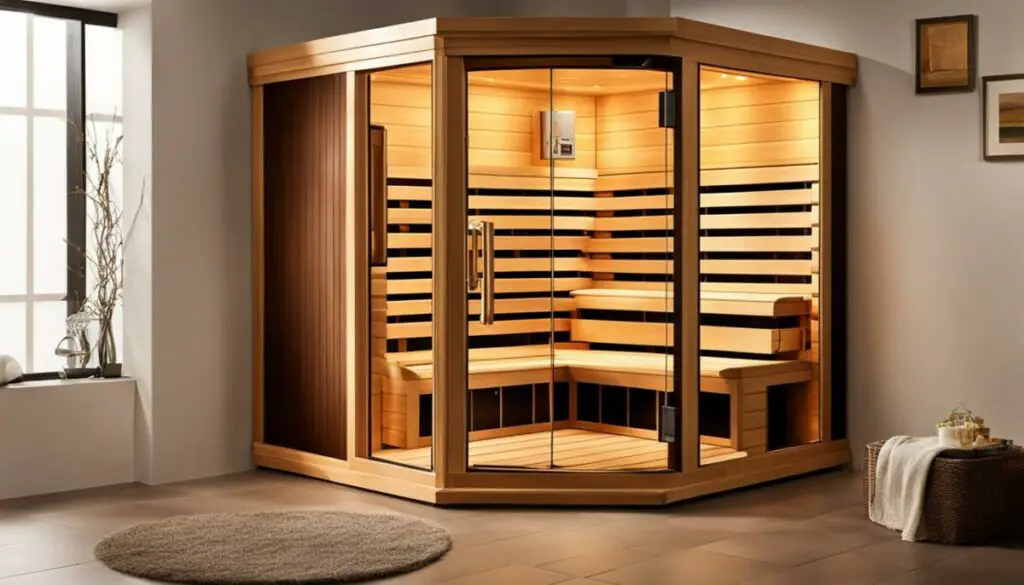
Infrared saunas come in a variety of sizes, shapes, and materials, allowing you to find the perfect fit for your needs and preferences. When choosing an infrared sauna, it’s important to consider the available sizes to ensure that it can accommodate the desired number of individuals. You can find compact saunas designed for 1 to 2 people, as well as larger options that can comfortably fit up to 6 people. Selecting the appropriate size will ensure everyone can enjoy the sauna experience comfortably.
The shapes of infrared saunas also vary, offering options beyond the traditional box-shaped design. You can find saunas with rounded corners or even uniquely shaped models that add a contemporary touch to your home. Consider the available space and your personal aesthetics when choosing the shape of your infrared sauna.
Materials used in infrared saunas play a crucial role in both functionality and aesthetics. Wood is a popular choice due to its natural, warm appeal and excellent heat insulation properties. Carbon fiber and ceramic are alternative materials used in some saunas, each offering unique benefits. Carbon fiber heats quickly, providing efficient and even heat distribution. Ceramic has excellent heat retention properties, allowing the sauna to remain warm even after the heater is turned off. Ultimately, the choice of material depends on your personal preferences and desired sauna experience.
Infrared Sauna Heaters
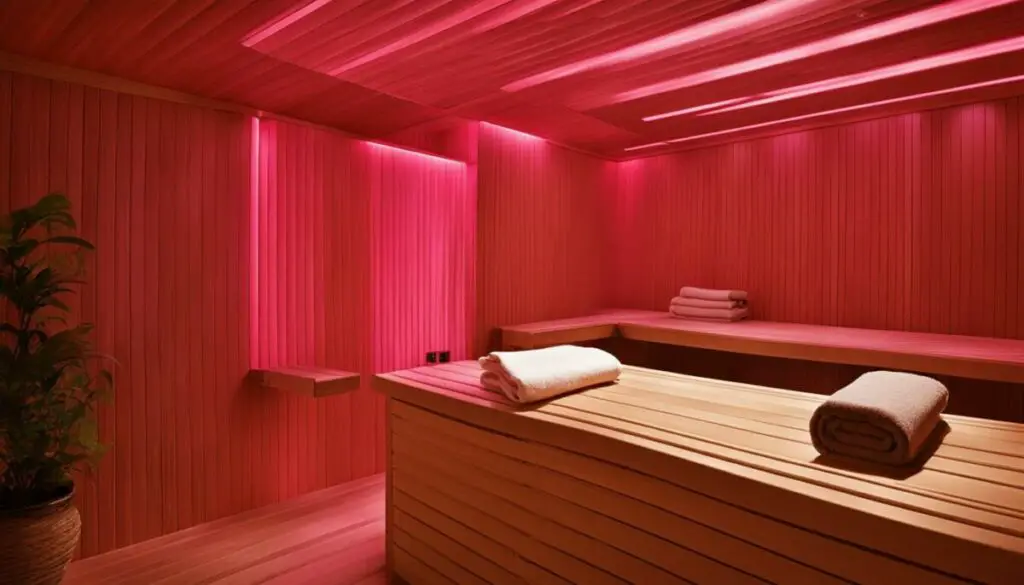
Infrared sauna heaters are a vital component of an infrared sauna, responsible for generating the therapeutic heat that promotes relaxation and wellness. Unlike traditional steam saunas that heat the air, infrared sauna panels emit infrared radiation that directly heats the body and objects within the sauna. This form of heating creates a gentle and soothing experience while still providing the desired health benefits. Infrared sauna panels are available in various technologies, with carbon fiber sauna heater panels being widely regarded as the most effective.
The use of carbon fiber in infrared sauna heaters allows for efficient heat distribution and even coverage throughout the sauna. Carbon heaters emit long wave infrared heat, which penetrates deeply into the body, promoting detoxification, improved circulation, and muscle relaxation. Carbon fiber sauna heater panels also offer enhanced safety features, as they maintain a lower surface temperature compared to other heating options.
When considering infrared sauna heaters for your sauna, it’s essential to choose a reputable brand that offers reliable and high-quality products. Investing in a well-designed and efficient infrared sauna heater will ensure optimal performance and a satisfying sauna experience.
Benefits of Infrared Sauna Heaters:
- Deep penetration of heat for increased detoxification and muscle relaxation.
- Even heat distribution for consistent and comfortable sauna sessions.
- Efficient and energy-saving technology for cost-effective operation.
- Enhanced safety features with lower surface temperatures.
- Longer lifespan compared to other sauna heater options.
Factors to Consider when Choosing Infrared Sauna Heaters:
- Heating technology: Carbon fiber sauna heater panels are considered the most effective.
- Safety features: Look for heaters with lower surface temperatures to minimize the risk of burns.
- Even heat distribution: Ensure the sauna heater provides consistent heat throughout the sauna.
- Energy efficiency: Consider the energy consumption of the heater for cost-effective operation.
- Brand reputation: Choose a reputable brand known for reliable and high-quality sauna heaters.
| Heater Type | Features | Advantages |
|---|---|---|
| Carbon Fiber Sauna Heater Panels | – Long wave infrared heat – Efficient heat distribution – Lower surface temperature |
– Deep penetration for detoxification and relaxation – Even and comfortable heat – Enhanced safety – Longer lifespan |
| Ceramic Sauna Heaters | – Immediate heat production – Energy-efficient – Lower purchasing costs |
– Quick heating – Cost-effective option |
| Carbon/Ceramic Combination Heaters | – Combined benefits of carbon and ceramic heaters | – Optimal heating experience |
Ceramic Heaters
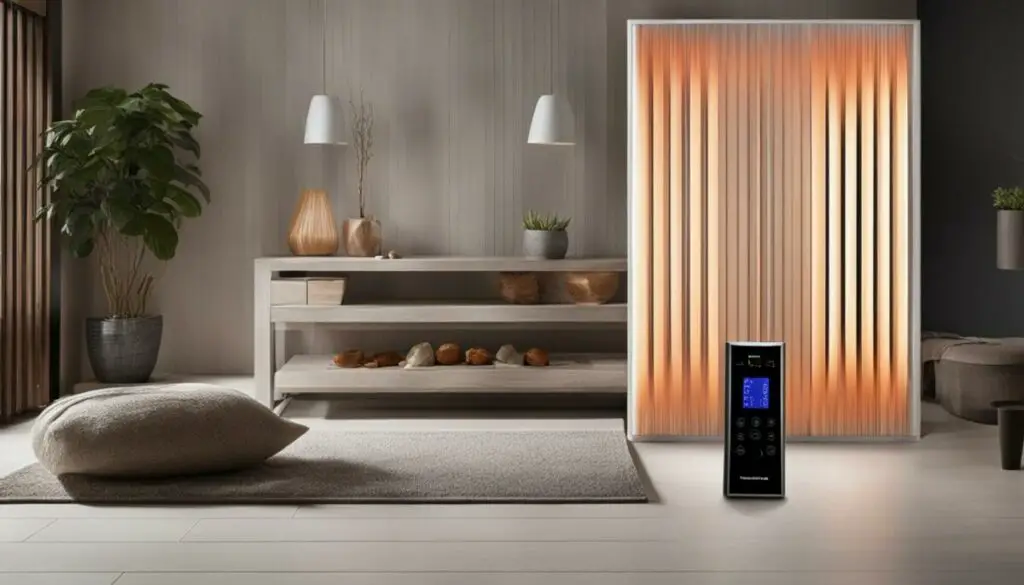
Ceramic heaters are a popular choice for infrared saunas due to their immediate heating efficiency and energy conservation capabilities. These heaters heat ceramic rods until they become red hot, producing a high quantity of heat in a short amount of time. This quick heat production ensures that the sauna reaches the desired temperature quickly, allowing users to enjoy their sauna session without delay.
One of the key advantages of ceramic heaters is their efficiency in conserving energy. They are designed to quickly convert electrical energy into heat, ensuring that minimal energy is wasted during the heating process. This energy efficiency not only helps reduce electricity costs but also makes ceramic heaters an environmentally friendly option.
However, it’s important to note that ceramic heaters have a shorter lifespan compared to other infrared sauna heater options. Due to the high temperatures they reach, there is a possibility of the ceramic material shattering or cracking over time. While they are durable and reliable heaters, regular maintenance and cautious handling are essential to prolong their lifespan and ensure safe usage.
Overall, ceramic heaters offer immediate heating, energy efficiency, and a cost-effective option for infrared saunas. They are particularly suitable for users who prioritize quick heat-up times and energy conservation.
Benefits of Ceramic Heaters:
- Immediate heating efficiency
- Energy conservation capabilities
- Cost-effective option
Considerations for Ceramic Heaters:
- Shorter lifespan compared to other heater options
- Requires regular maintenance and cautious handling
Table: Comparison of Infrared Sauna Heater Types
| Heater Type | Efficiency | Lifespan | Immediate Heating |
|---|---|---|---|
| Ceramic Heaters | High | Shorter lifespan compared to other options | Yes |
| Carbon Heaters | Very High | Long | No immediate heating, requires warm-up time |
| Carbon/Ceramic Combination Heaters | High | Long | Yes |
Carbon Heaters
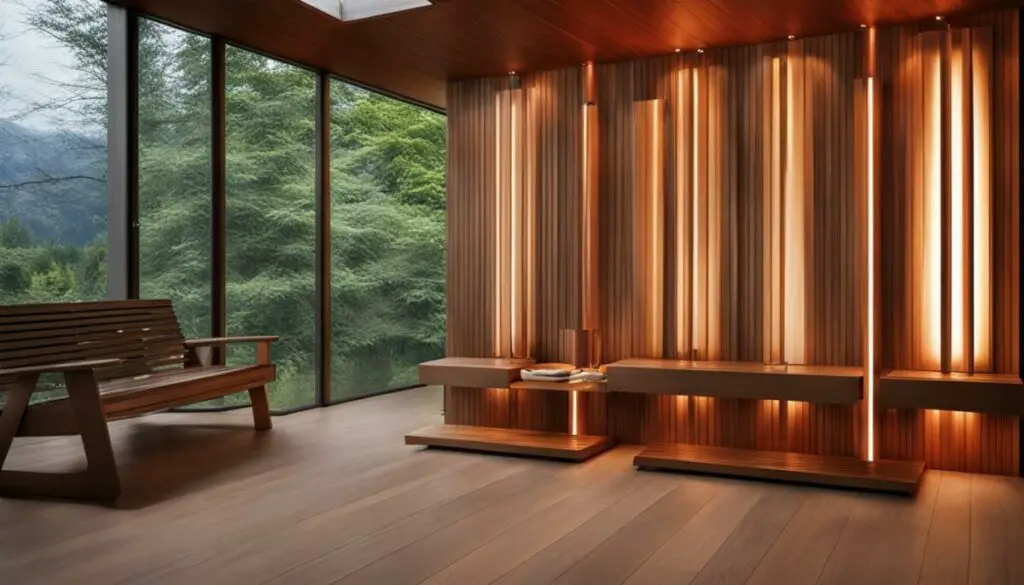
When it comes to infrared sauna heaters, carbon heaters are a popular choice. These heaters, also known as carbon fiber heaters, are designed to produce long wave infrared heat, making them ideal for creating a gentle and powerful heat in the sauna. One of the key advantages of carbon heaters is their efficiency. In fact, carbon heaters offer 40% more efficiency than ceramic heaters, ensuring that you get the most out of your sauna sessions.
Another benefit of carbon heaters is their lifespan. Carbon fiber heaters are known for their durability and longevity, making them a reliable option for sauna heating. Unlike ceramic heaters that can shatter or crack, carbon heaters are more resistant to damage, ensuring that they can withstand regular use over an extended period of time.
In addition to their efficiency and lifespan, carbon heaters also provide even heat distribution throughout the sauna. This means that your body will be exposed to consistent heat, allowing for a more comfortable and enjoyable sauna experience. With all these advantages, it’s no wonder that carbon heaters are a popular choice for those looking to enhance their sauna sessions.
| Advantages of Carbon Heaters | Disadvantages of Carbon Heaters |
|---|---|
|
|
Carbon/Ceramic Combination Heaters
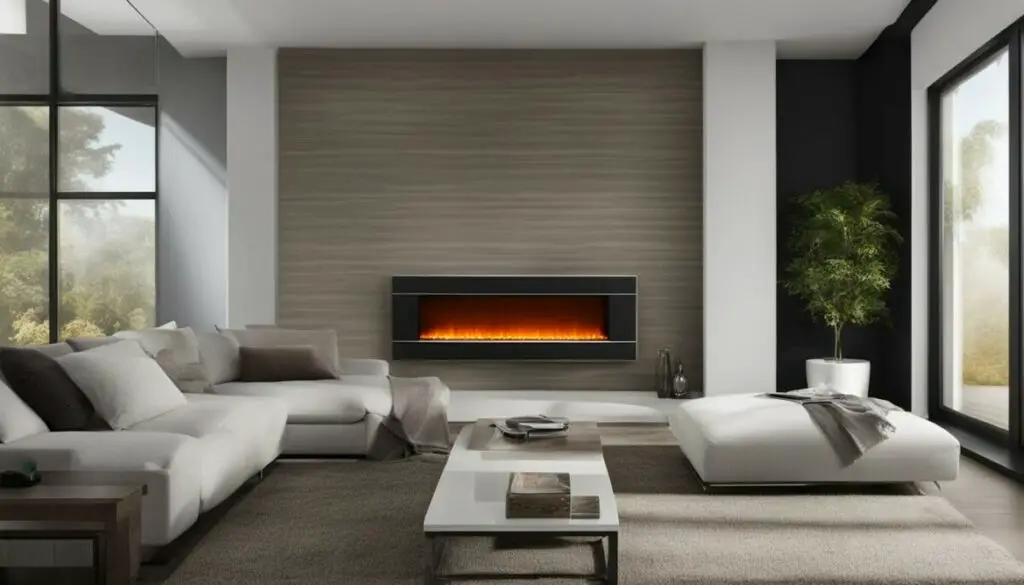
Carbon/ceramic combination heaters are a popular choice for infrared saunas, as they offer the best of both worlds. These heaters combine the safety and durability of carbon heaters with the quick-heating capability and affordability of ceramic heaters.
With carbon/ceramic combination heaters, you can enjoy the benefits of even heat distribution and energy efficiency that carbon heaters provide, while also experiencing the immediate heat production and lower purchasing costs associated with ceramic heaters. These heaters use a combination of carbon fiber and ceramic rods to create a balanced heating experience.
By combining these two heating technologies, carbon/ceramic combination heaters offer optimal heat output and performance in an infrared sauna. They provide a comfortable and effective sauna experience, allowing you to relax and enjoy the therapeutic benefits of infrared heat.
Infrared Sauna Heater Comparison
When it comes to choosing the right infrared sauna heater, it’s important to understand the differences between the available options. Two popular types of heaters are ceramic heaters and carbon heaters. Let’s compare them to help you make an informed decision:
Ceramic Heaters
Ceramic heaters are known for their immediate heating capabilities. They can quickly produce high quantities of heat, making them an efficient choice for those who want to start enjoying their sauna experience without waiting for the sauna to warm up. However, it’s worth noting that ceramic heaters have a shorter lifespan compared to carbon heaters due to the possibility of shattering or cracking of the ceramic material.
Carbon Heaters
Carbon heaters, also known as carbon fiber heaters, offer a gentle yet powerful heat. They distribute heat evenly throughout the sauna, providing a consistent and comfortable experience. Carbon heaters are more durable and have a significantly lower risk of damage or breaking compared to ceramic heaters. They are also known for their safety and efficiency, offering 40% more efficiency than ceramic heaters.
| Heater Type | Immediate Heating | Lifespan | Efficiency | Durability |
|---|---|---|---|---|
| Ceramic Heaters | Yes | Shorter | Lower | Lower |
| Carbon Heaters | No | Longer | Higher | Higher |
As shown in the table above, ceramic heaters provide immediate heating, but they have a shorter lifespan and lower efficiency compared to carbon heaters. On the other hand, carbon heaters offer a longer lifespan and higher efficiency, making them a more durable and energy-efficient choice for your infrared sauna.
Ultimately, the choice between ceramic and carbon heaters will depend on your personal preferences and priorities. If immediate heating is a top priority, ceramic heaters may be the right choice for you. However, if durability and efficiency are more important, carbon heaters are a great option. Consider your specific needs and preferences when making your decision.
Conclusion
In conclusion, when choosing between far infrared heating panels and sauna panels, it’s important to consider your specific needs and requirements. Far infrared heating panels are ideal for indoor heating purposes, providing efficient and comfortable warmth throughout your space. On the other hand, sauna panels are specifically designed for use in saunas, offering the perfect temperature and environment for relaxation and rejuvenation.
Both types of panels utilize infrared technology to produce heat, but understanding their differences is crucial. Far infrared heating panels are made with materials suitable for heating indoor spaces, while sauna panels are crafted to withstand the high temperatures and humidity levels found in saunas.
When making your decision, consider factors such as intended use, efficiency, and durability. If you’re looking for a heating solution for your home or office, far infrared heating panels are a great choice. However, if you’re creating a sauna experience in your own space, sauna panels are the way to go. Ultimately, it’s about choosing the option that best suits your needs and preferences.
FAQ
Are far infrared heating panels and sauna panels the same?
No, far infrared heating panels and sauna panels are not the same. They are designed for different purposes and have differences in materials and heating capabilities.
What are the types of infrared sauna heaters?
The three main types of infrared sauna heaters are carbon heaters, ceramic heaters, and carbon/ceramic combination heaters.
What are the sizes, shapes, and materials of infrared saunas?
Infrared saunas come in various sizes, shapes, and materials. They range from compact 1 to 2-person saunas to larger 6-person saunas, and can be made from wood, carbon fiber, ceramic, and other materials.
What are infrared sauna heaters?
Infrared sauna heaters play a crucial role in the functioning of an infrared sauna. They heat objects directly rather than the air, resulting in a cooler interior sauna air temperature while still providing the same effects to the body.
What are ceramic heaters?
Ceramic heaters are a type of infrared sauna heater that heat ceramic rods until they become red hot. They provide immediate heating and are energy-efficient, but have a shorter lifespan compared to other heater options.
What are carbon heaters?
Carbon heaters, also known as carbon fiber heaters, are a type of infrared sauna heater that produces long wave infrared heat. They are known for their safety, efficiency, and the ability to emit a gentle yet powerful heat.
What are carbon/ceramic combination heaters?
Carbon/ceramic combination heaters are a type of infrared sauna heater that combines the benefits of both carbon and ceramic heaters. They provide the safety and durability of carbon heaters, as well as the quick-heating capability and affordability of ceramic heaters.
How do infrared sauna heaters compare?
When comparing infrared sauna heaters, it’s important to consider their effectiveness in producing infrared light and heat. Ceramic heaters have high heat retention and absorption properties, while carbon heaters provide a longer wavelength of infrared light for maximum absorption. Combination heaters offer a balance between higher surface temperature and optimal wavelength for infrared energy absorption.
How do I choose between far infrared heating panels and sauna panels?
When choosing between far infrared heating panels and sauna panels, it’s essential to consider factors such as intended use, efficiency, durability, and personal preferences. Understanding the distinctions between these panels can help make an informed decision based on individual needs and requirements.









